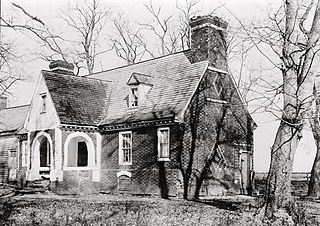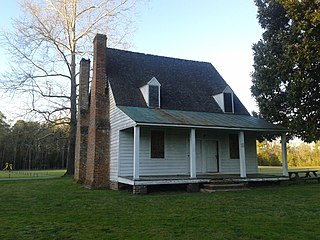
Chippokes Plantation State Park is located at 695 Chippokes Park Road, Surry, Virginia. It is in a rural, agricultural area off the James River and Route 10 in Surry County, and is protected under the state park system.

Bacon's Castle, also variously known as "Allen's Brick House" or the "Arthur Allen House" is located in Surry County, Virginia, United States, and is the oldest documented brick dwelling in what is now the United States. Built in 1665, it is noted as an extremely rare example of Jacobean architecture in the New World.

Malvern Hill stands on the north bank of the James River in Henrico County, Virginia, USA, about eighteen miles southeast of Richmond. On 1 July 1862, it was the scene of the Battle of Malvern Hill, one of the Seven Days Battles of the American Civil War.
Curles Neck Plantation is located between State Route 5 and the north bank of the James River in the Varina district of Henrico County, Virginia. One of the great James River Plantations, Curles Neck has remained in active use for almost 400 years and remains a privately owned working farm which is not currently open to the public.

Smith's Fort Plantation is a house and parcel of land located in Surry County, Virginia, United States. The current main house on the property, also known as the Faulcon House, dates from 1751. The house has been an example for numerous twentieth century reproductions. It is also known as Warren House and Rolfe-Warren House.

Ingleside Vineyards is a winery located in the Northern Neck George Washington Birthplace AVA, an American Viticultural Area located in the Northern Neck region of Virginia. Ingleside is one of the oldest and largest wineries in the state, established in 1980, and part of an estate of over 3,000 acres (12 km2) owned by the Flemer family since 1890.

Spence's Point is a historic estate on the Potomac River near Westmoreland, Virginia. Also known as the John R. Dos Passos Farm, it was the home of writer John Dos Passos (1896–1970) for the last 25 years of his life. It was declared a National Historic Landmark in 1971.

The Anchorage is an historic house located in Northumberland County, seven miles (NE) outside of Kilmarnock, Virginia, near Wicomico Church, Virginia.

This is a list of the National Register of Historic Places listings in Henrico County, Virginia.

Windsor Shades is located on the Pamunkey River in Sweet Hall, Virginia, United States, that is listed on the National Register of Historic Places. Archeological native artifacts found on the property surrounding the house suggest it was the site of Kupkipcok, a Pamunkey village noted on John Smith's 1609 map.

Montpelier is a historic home in Surry County, Virginia, located near Cabin Point. While the home's builder and date of construction are uncertain, it was built by a member of the Cocke family, most likely one of two men named John Cocke. Its layout and architecture suggest that it was built in the latter half of the eighteenth century, although its date of construction has also been cited as circa 1724. The house is considered to be an "unusually distinctive example" of vernacular architecture in the Tidewater region; additionally, its features and layout provide important evidence as to how local architecture developed in the region. The house was added to the National Register of Historic Places on March 26, 1980.

Evelynton is a historic home near Charles City, Charles City County, in the U.S. state of Virginia. It was built in 1937, and is a two-story, seven bay, brick dwelling in the Colonial Revival style. It has a gable roof with dormers, and flanking dependencies connected to the main house by hyphens. Also on the property is a contributing frame servants' quarters. It was designed and built under the supervision of the prominent architect W. Duncan Lee (1884–1952).
Howard's Neck Plantation is a historic house and plantation complex located near the unincorporated community of Pemberton, in Goochland County, Virginia. It was built about 1825, and is a two-story, three-bay brick structure in the Federal style. The house is similar in style to the works of Robert Mills. It has a shallow deck-on-hip roof and a small, one-story academically proportioned tetrastyle Roman Doric order portico.

The Dover Slave Quarter Complex is a set of five historic structures located on Brookview Farm near Manakin-Sabot, Goochland County, Virginia. They were built as one-story, two-unit, brick structures with steep gable roofs for housing African slaves. The houses are arranged in a wide arc, measuring 360 feet in length. The center dwelling had a frame second-story added and its brick walls covered by siding when it was converted to an overseer's house. It has a recent rear addition.

Aberdeen is a historic plantation house located several miles north of Disputanta, Prince George County, Virginia. It was built sometime between 1790 and 1810, by Thomas Cocke. In 1790 Thomas inherited a 1,685-acre portion of his father's estate, Bonnacord, which he named "Aberdeen." Thomas's brother, John P. Cocke, inherited the remainder of Bonnacord. Thomas married Sarah Colley, daughter of Nathaniel and Martha Batte Colley of Tar Bay Plantation located about five miles west of Bonnacord.

Evergreen, one of the James River Plantations is a historic plantation house located just east of Hopewell, in Prince George County, Virginia. It was built about 1807 by planter, George Ruffin, and is a two-story, five-bay, Late Georgian / Federal style stuccoed brick dwelling. It sits on a high basement and has a hipped roof. The front facade features a one-story pedimented Doric order portico set on a brick podium. George Ruffin's son, ardent secessionist Edmund Ruffin, who is credited with firing one of the first shots at Fort Sumter at the start of the Civil War was born at Evergreen in 1794. The house was extensively renovated in the late-1930s, after prior use as a barn and stable.

Snow Hill, also known as Booth House, is a historic home located near Gwaltney Corner, Surry County, Virginia. It was built in 1836, and is a 2+1⁄2-story, five bay, I-house style frame dwelling. It has a gable roof, exterior end chimneys, and a single pile, central-hall plan. The interior features special decorative treatment of the woodwork in imitation of fine woods and marbles.

Enos House, also known as Warren House, is a historic home located on Enos Farm Drive near Surry, Surry County, Virginia. It was built about 1810, and is a 1+1⁄2-story, double pile hall-parlor plan frame dwelling. It has a gable roof and features a low, full-length shed porch on the front facade. It has a 20th-century rear ell.

Glebe House of Southwark Parish, also known as The Old Glebe, is a historic glebe house located near Spring Grove, Surry County, Virginia. It was built about 1724, and is a 1+1⁄2-story, three bay, single pile, central-hall plan brick dwelling. It has a gambrel roof with dormers, added in the 19th century, has exterior end chimneys, and sits on a brick basement. Also on the property is a contributing frame smokehouse. The glebe house was sold, as required by the legislature during the Disestablishment of 1802. It was subsequently remodeled and used as a private dwelling.It sits on the site of Indian Spring Plantation patented by Nicholas Merriweather in 1666. The property is currently owned by the Perkins family.





















